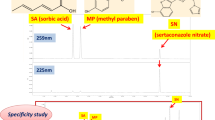Modern antimicrobial preservatives authorized for use in dosage form technology are reviewed. The nomenclature and various classifications of preservatives according to chemical nature, mechanism and spectrum of antimicrobial action, optimum effective concentrations for antimicrobial activity, and separate factors affecting the activity of antimicrobial preservatives in various dosage forms, e.g., optimum solution pH values and specific adsorbents reducing preservative activity, are presented. Antimicrobial preservatives used widely in pharmaceutical technology, i.e., parabens, sorbic acid and its salts, benzoic acid and its salts, and benzalkonium chloride, are discussed in detail. Ascience-based approach to selecting antimicrobial preservatives is shown to produce the most stable and safest medicines.

Similar content being viewed by others
References
N. N. Firsov, Microbiology: Dictionary of Terms [in Russian], Drofa, Moscow, 2006.
S. P. Anand and N. Sati, Int. J. Pharm. Sci. Res., 4(7), 2496 – 2501 (2013).
O. E. Belikov and T. V. Puchkova, Preservatives in Cosmetics and Sanitary Media [in Russian], Shkola Kosmeticheskikh Khimikov, Moscow, 2003.
State Pharmacopoeia of the Russian Federation [in Russian], XIIIth Ed., Moscow, 2015; Federal Electronic Medical Library; http: // femb.ru / feml (accessed July 25, 2017).
European Pharmacopoeia, 8.0 Ed., 2014.
Pharmacopeia of the United States, USP38 / NF33, 2015.
H. A. Pawar, et al., Int. J. Pharm. Phytopharmacol. Res., 1(2), 78 – 88 (2011).
S. V. W. Sutton and D. Porter, PDA J. Pharm. Sci. Technol., 56(6), 300 – 311 (2002).
A. V. Titova, Doctoral Dissertation, Moscow, 2006.
E. Lyuk and M. Yager, Preservatives in the Food Industry. Properties and Applications [in Russian], GIORD, St. Petersburg, 2000.
L. V. Kolosova, Candidate Dissertation, St. Petersburg, 2016.
A. Singh, P. K. Sharma, and G. Garg, Int. J. Pharm. Bio Sci., 1(4), 601 – 612 (2010).
J.-S. Choi, Y.-R. Lee, Y.-M. Ha, et al., J. Food Sci., 79(6), M1159 – M1167 (2014).
Analytical Portal of the Chemical Industry “New Chemical Technologies” [in Russian]; http: // www.newchemistry.ru/letter. php?nid=1629 (accessed July 2, 2017).
S. M. Shaikh, R. C. Doijad, A. S. Shete, et al., PharmaTutor, 4(5), 25 – 34 (2016).
L. V. Allen, Jr., Secundem Artem, 18(1), 1 – 8 (2014).
“EC changes allowed concentrations of another three preservatives, raw material and packaging for perfumes, cosmetics, and household chemicals,” Syr’e Upakovka dlya Parfyumerii, Kosmetiki i Bytovoi Khimii, No. 08 (159), October, 2014; https: // cosmetic-industry.com / es-menyaet-dopustimye-koncentracii-eshhe-trex-konservantov.html (accessed July 2, 2017).
J. Swarbrick (ed.), Encyclopedia of Pharmaceutical Technology, PharmaceuTech, Informa Healthcare USA, Inc., USA, 2007.
C. A. Rasmussen, P. L. Kaufman, and J. A. Kiland, J. Ocul. Pharmacol. Ther., 30(2 – 3), 163 – 169 (2014).
R. W. Yee, Curr. Opin. Ophthalmol., 18, 134 – 139 (2007).
Iqbal Ahmad and K. A. Chishti, Pak. J. Pharm. Sci., 5(1), 25 – 36 (1992).
D. P. Elder and P. J. Crowley, Am. Pharm. Rev. (2013); http: //www.americanpharmaceuticalreview.com/Featured-Articles / (accessed June 12, 2017).
R. C. Rowe, P. J. Sheskey, and P. J. Weller (eds.), Handbook of Pharmaceutical Excipients, Fifth Ed., Pharmaceutical Press, 2006.
S. C. Owen, Handbook of Pharmaceutical Excipients, Fifth Ed., Pharmaceutical Press, 2006.
R. Johnson and R. Steer, Handbook of Pharmaceutical Excipients, Fifth Ed., Pharmaceutical Press, 2006.
Preservative-Free Ophthalmic Products, Scope e-Knowledge Center Pvt Ltd., 2013; https: // www.slideshare.net/Scope-Knowledge/preservative-free-ophthalmic-products (accessed September 3, 2017).
F. Brignole-Baudouin, L. Riancho, H. Liang, et al., J. Ocul. Pharmacol. Ther., 27, 273 – 280 (2011).
C. Baudouin, A. Labbe, H. Liang, et al., Prog. Retinal Eye Res., 29, 312 – 334 (2010).
P. D. Freeman and M. Y. Kahook, Expert Rev. Ophthalmol., 4, 59 – 64 (2009).
S. P. Epstein, J. Ocul. Pharmacol. Ther., 25, 113 – 119 (2009).
M. Aihara, H. Oshima, and M. Araie, Acta Ophthalmol., 91, e7-e14 (2013).
Author information
Authors and Affiliations
Corresponding author
Additional information
Translated from Khimiko-Farmatsevticheskii Zhurnal, Vol. 53, No. 6, pp. 54 – 61, June, 2019.
Rights and permissions
About this article
Cite this article
Anurova, M.N., Bakhrushina, E.O., Demina, N.B. et al. Modern Preservatives of Microbiological Stability (Review). Pharm Chem J 53, 564–571 (2019). https://doi.org/10.1007/s11094-019-02038-4
Received:
Published:
Issue Date:
DOI: https://doi.org/10.1007/s11094-019-02038-4




